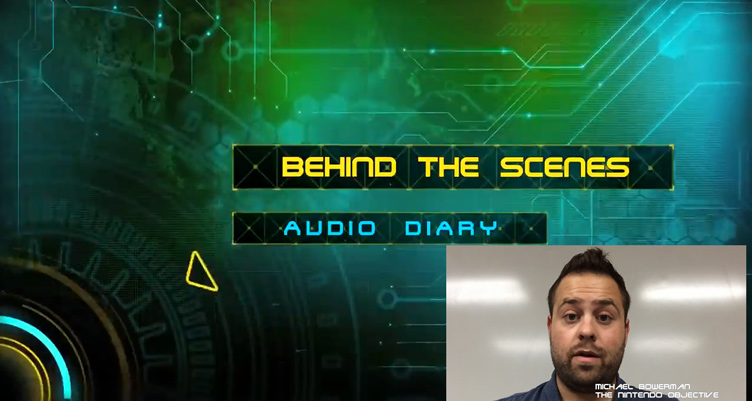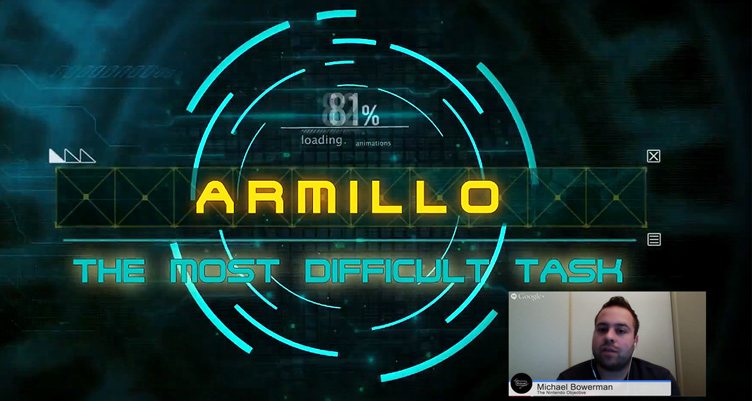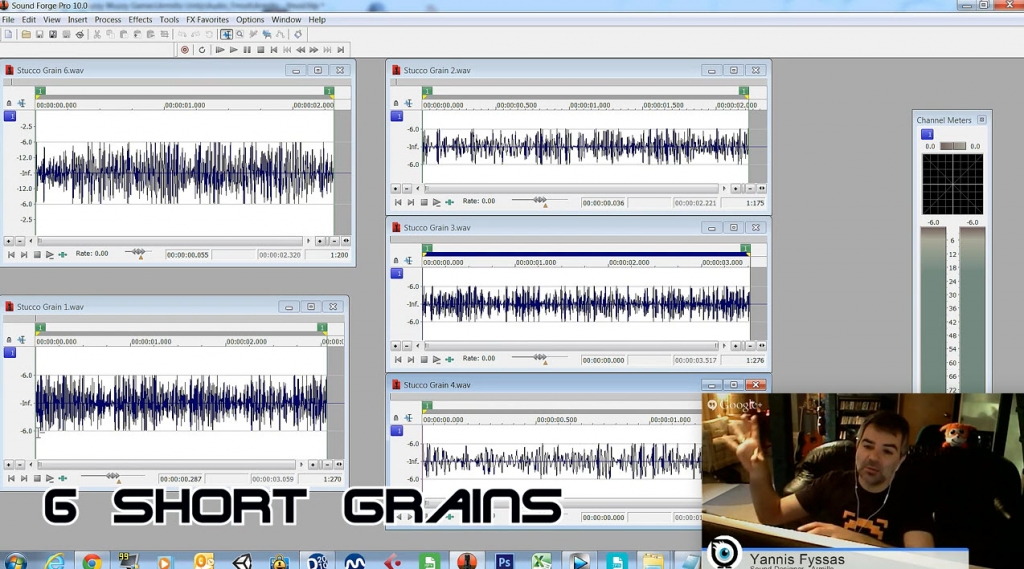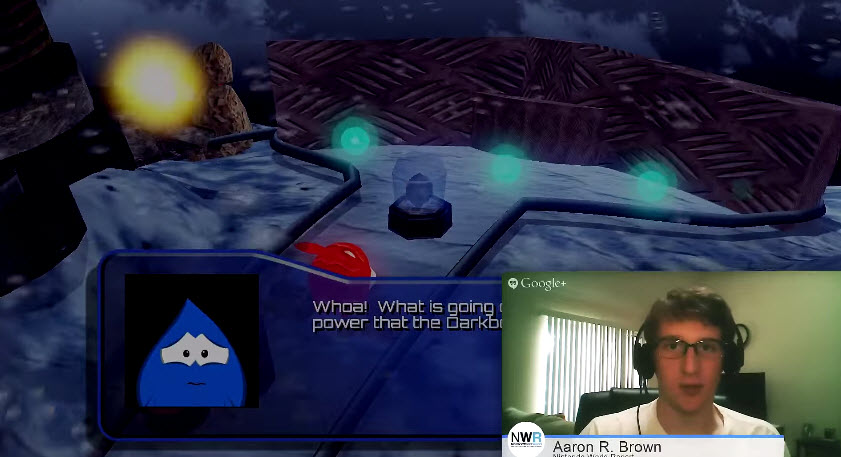Project Description
In this online interview Jason Lepine & Shawn Long interview Yanni from Fuzzy Wuzzy Games to discuss the development process of Armillo.
Transcription kindly provided by David hooker @Agentdave7
Jason Lepine: Hey everyone and welcome to a special online interview on Indie Corner. With me today I have Yanni, from Fuzzy Wuzzy Games, as well as Shawn Long, joining us from Nintendo Enthusiast. How are you guys doing today?
Yanni Fyssas: Hey guys! It’s good to be here. We’re doing just great over here in Vancouver.
Shawn Long: Doing good in North Carolina.
Jason Lepine: Yanni, obviously you have just released a game, Armillo, on the Wii U eshop. Can you give us a little bit of a highlight of what Armillo is all about?
Yanni Fyssas: Sure. Armillo is a 3D puzzle platformer. At its core it’s basically a platformer with a whole lot of mechanics. Think of it like an obstacle course. We borrow some ideas from other games like Sonic and Mario Galaxy but I think what sets us apart is in the way that we make our own “sauce”. We’ve got the ingredients that you’ve seen before, like tomatoes and herbs. But the way that we put it together and the experience, I think, is what sets Armillo apart from other platformers.
Jason Lepine: Armillo came out on the Wii U eShop, exclusively. Is there a reason why you chose the Wii U as your first console to release on? Why not simultaneously release on Steam?
Yanni Fyssas: The thing with doing multi-platform launches is they take an incredible amount of effort. As you guys probably know with Armillo, it’s a 3D platformer and there is not a lot of those out there and the reason for that is because they take a lot more effort to do than a 2D side-scrolling platformer. Not that there is anything wrong with those, but it’s just the sheer volume of assets that you need to do for 3D is way more. The only hope that we had of actually releasing anything that would be decent, would be to really focus our energies on one platform, try to get that right (or, at least, as right as we could with a small team of 2, basically 2½ people), then just do our best job releasing on one platform.
The reason we did the Wii U is because originally we used to be on XBLA, and through the cert. process of Microsoft it became obvious that that probably wasn’t the best platform for us, and that Microsoft was not really interested. We sat around and thought about, “Well, what would be our ideal console to release on?” The Wii U came up a couple of times. Basically, to answer your question of why we picked it, it’s the best fit for the game. Like Armillo, to me, is very much a console type platformer in the genre of the Marios and the Sonics of the world. I think it really sits nicely on that platform. To boot, I think most of the users would be immediately familiar with this kind of game.
Shawn Long: Now I know you’re talking about how you borrowed some basic ideas from Sonic and Mario, but one of the ideas I see Armillo borrowing is the whole “mascot thing”, which with Sonic and Mario, was very common during the 90’s. You had everyone trying to do a mascot with Bubsy, Sparkster (from Rocket Knight Adventures), all those classic games, whereas nowadays you don’t really see many new mascots try to come out. Was that an inspiration for Armillo? Did you want to make a mascot game? How did that really work?
Yanni Fyssas: When we started Armillo I put together a team of about 30 advisers, and those advisers were a wide range of people. Some of them were just gamers that were friends of ours. Some of them were people at Electronic Arts. There’s CEOs, CFOs, general studio managers, people very high up, audio directors, other indie developers. All these people we used throughout the process, and still use to get ideas from, inspiration and just to help us guide the path of design, marketing, and what Armillo is.
Very early, we played the game, had a bunch of people come over and play it and I had Jamie Cheng from Klei Entertainment (who did Mark of the Ninja). Jamie’s feedback was, “This is interesting, but an inanimate ball is not of much interest, not these days. Maybe 20 years ago Marble Madness was king and it was great, but you need to engage users in some other level, other than just the ball and the mechanics.” He said, “Basically, you need a character.” So we regrouped. We got together with the whole team, and kicked around, “What should this ball be? What kind of characters do we like?” I’ve got cats, so I love cats. James, at the time, had a Shiba Inu dog, which was absolutely adorable. So we wanted that in there. I kicked around the Firefox idea. Our art director, at the time, had two rabbits (he still has rabbits). We basically threw all the stuff at Terry and went, “Here Terry, why don’t you take all this stuff and mash it up?”
Back came about ten drawings of potential ideas, and we then kicked those around a bit. Terry made some changes. We all put in our two cents. We came up with the original Armillo idea and we all decided that an armadillo seems cool because it’s hard, it rolls. Sure, we’ll buy that, but it’s got to be cuter than an armadillo because armadillos are kinda ugly. After he came back, Ron did the first 3D model and then he further refined it and completely changed the eyes. That’s why we ended up there. We never set out to make a game with a mascot. We just tried to solve the initial problem that we had, which was not a whole lot of engagement for a ball.
Jason Lepine: Very interesting. Yanni you were also saying that Armillo was originally a concept meant for phones. That is something we had talked about before going live. Can you explain how the design changed over time? How did it go from being the simple smartphone to this full-fledged game on the Wii U?
Yanni Fyssas: After we got laid off from EA in 2010, James called me because me and James had worked at EA together. I had done a bunch of audio stuff that he was digging. He said, “Hey, I got this idea for a mobile game, and I want to start a company. Are you interested in joining?” James is one of those developers that really values audio and music, and I think that shows at the end of Armillo.
We get together and he shows us this game. Basically it’s a disc, and you rotate the disc, and you’ve got a ball. The ball goes down, and there’s lasers you have to avoid. There’s a couple of pinball bouncers, and all these things, and we looked at all that (I think there were 3 or 4 of us at the time, Ron was there). We were like, “Yeah, that’s kind of cool. Let’s work with that.”
The following week, Ron comes back and he’s like, “Hey guys, I took that idea. I extracted the rails, modelled the 3D planet. Here’s some vegetation. Here’s some atmosphere. Here’s what it would look like if we were to transpose this onto a 3D plane.” So we all just sat back and went, “Holy crap! What just happened? This thing looks amazing.” It looked beautiful, and we went, “Yeah, so this looks like a very complicated thing to do. James is it possible to do this?” James was like, “I don’t know man. This is a 2D thing. It’s got fixed vector mapping. It’s pretty simple. This 3D thing is basically a console game. I don’t know. It looks pretty complicated. I don’t know what we’re going to do.” I said, ”Okay, whatever. Just have a look at it, and see what you can do.”
3 days later, I get an email. He goes, “Yeah, I actually took all the assets from Ron, and mapped them into 3D-Sphere. I’ve figured out a way, how to map all the paths. Now we’re just going to work on my end, create some export script so that Ron can work on their sculpt and export stuff.” So that’s how we went from a phone game to an actual 3D platformer.
Jason Lepine: Now an interesting thing, some similarities I see here is, as you were saying, you mapped this to the 3D world and you had to adapt 2D game design in 3D. This made me think a lot of our old friend Sonic, how he used to be a great game in 2D, and has been struggling a lot over the past decade for 3D. Armillo employs this use of rails. Was that challenging to work in the 3D world? How difficult was it to balance controlling, giving the player full control, and also making sure they’re not always falling in a pit every 5 seconds?
Yanni Fyssas: That’s a really good question, because it talks about design and progression. The rails remove one of the dimensions. You are only really able to move in one dimension, usually in a line. That’s how it starts. That’s how we teach you to roll and navigate. Once you get good at that, we open it up. We have some platforms that are open, but at this point, you’ve learned how to navigate. You start grasping the 3/4 down camera perspective, and it becomes easy. We don’t just open it all up.
The thing with game design is you need some kind of constraints to balance out what your game is gonna be. If you can do anything at any given time, it’s not a very interesting thing. The things that I find interesting are problems that have constraints. How you can creatively solve those constraints can still make it an interesting experience. The fact that there are rails I think is really interesting, and it becomes much more easier to manage.
In terms of it being a problem, it was a constraint that we embraced. It helped us develop Armillo into what it is. If it was an open world platformer, Armillo would be a very, very different game. I don’t think it would speak to the casual audience, the way that Armillo does now.
Shawn Long: We’ve been talking a lot about the 3D game design of it, but Armillo has those Secret Levels, which are 2D levels that are inspired by old platforming games, like Castlevania, and even there are elements of the 2D Sonic games. How did those get incorporated into the game? Did you plan on having some 3D and 2D levels side-by-side, or was that added after the fact?
Yanni Fyssas: At PAX 2011, I met with the Amazon guys, and some UbiSoft guys, and talked to Microsoft. One of the things that kept coming up was that the game just wasn’t going to be long enough. At that time, we were probably getting 2 or 3 hours in, and everyone pretty much said, “Look, we can’t sell this game, unless it’s an 8-hour game.” Now at that point, we were kind of “flirting with publishers”. We didn’t really have the whole publisher thing figured out. We were just kicking the idea around. We knew we had to make it longer. It’s pretty much impossible to do anymore content than Armillo already has. The moons were semi-procedurally generated art-wise. That gave us another 20 worlds, but that still wasn’t enough.
Halfway through the process, when we had a cool-down period of about 8 months we weren’t really sure what we were going to do with the game. James started working on a couple of mobile games. The second one that he did was a lot like the 2D stages in Armillo. When we were revisiting, “Okay, we need ‘x’ number of levels, and the gameplay needs to be this long.” James had the idea, “Well, why don’t I work on some of this 2D stuff, and factor it in. Instead of some rolling object, we’ll just make Armillo roll in 2D, and see if we can find some way to break that transition from 3D to 2D, and make it so that it’s not awkward.” Because it used to be that you would find these in the 3D world. Then you immediately go into 2D, which broke some design rules. So James thought, “You know what, I’ll make them unlockables. I’ll make you go back in the front end, which is basically 2D hud stuff.” So when you get to the 2D it’s not such an abrasive change of, “Okay, what happened? I was just playing 3D, and now I’m in some 2D thing.” So that’s how it came about. It was more about trying to merge some of the content that we had on the mobile device and extend the life of Armillo.
Jason Lepine: We are seeing a lot of life in Armillo with all the 3D moons, 2D platformers. There’s just a lot of game to be had in Armillo. Now I’m actually surprised that the price point for Armillo, given that there is so much content, right now it’s currently at $6, here in the eShop (I think the price is going up to $8 later on). Is there a reason why you picked that price point, and not what the higher indies are charging? We’re seeing $15/16 as being more of the higher-end indie games right now.
Yanni Fyssas: There’s pros and cons. The lower price point paints us in a budget kind of corner, which isn’t great. But also, it lets some of the players that don’t know our studio, take a chance on us. We have a lot to prove. We’re a new studio, and this is a new game. We’re just starting our trek into the world of making video games, as Fuzzy Wuzzy. We wanted to be fair with the pricing. We wanted a lot of people to try Armillo. We really weren’t sure how it was going to be received. We thought, maybe at its best, not to go for the higher end of the indie games, pick something that’s middle-road pricing-wise, try to bring in new players that might be interested in Armillo, but make the price not be the friction point in them getting into Armillo and trying it out.
Shawn Long: The price point seems to be helping, because Armillo seems to be selling really well. When it was released, it came out with a whole slew of other eShop games, but as I like to say, “The cream of the crop, rises to the top.” It’s been blowing up the charts for the eShop. It’s currently, making a good rise in the US. It’s #1 in some territories. I think it’s #3 in Canada. With the continued success of the game, do you see adding additional content to the game? Even Armillo himself is a very marketable character. Could you see doing some merchandising with him (t-shirts, plushies, things like that)? What’s the 6-12 months, from now, vision for Armillo?
Yanni Fyssas: What we’d like to do (depending on how Armillo does), is add some more content to the game. We’ve talked about what some of that content might be. We kicked the idea around of having local multiplayer, which I think would be really fun. We had that on the XBLA build, and it was a lot of fun. All this stuff takes time. We’d love to have plushies, but all that stuff takes a lot of effort to put together, and some of it takes resources. Multiplayer isn’t going to happen in a week. It’s probably a couple months worth of design, testing, programming, and all the art and audio that goes with it. We really need to balance our time. We need to balance the work life. We’ve been working really hard for the last year, trying to get Armillo out. The team health has suffered a bit. We want to make sure we do all of these in a healthy way, focus on the things that are the best for the Armillo fans (like what’s the biggest bang for their buck, that we can do), keep our ears open and listen to what people are saying. People on Twitter and Miiverse have been asking for certain things. We’re listening to the community, and trying to see what the right move is. Basically, look at it like this, imagine you have a task list of a 100 things. You could do any of them tomorrow. You know that within the next 3 months you’re only gonna get through 30 of those. You really need to decide what’s the best 30 things to do, and focus there. All these things are great ideas, it’s just every day, every week, I re-evaluate what we’re doing. I look at where we’re at, and we plan that way.
Jason Lepine: If you do decide to get into Armillo plushies, definitely count me down as a customer for that. Now Fuzzy Wuzzy Games is definitely out of the gate with a great start (first game is Armillo). I’ve played it. I love it. It’s a great game. Do you guys have any plans for a follow-up game, or are you still in a cooldown period and you haven’t thought that far out yet?
Yanni Fyssas: With a small team like this, it’s very hard to multitask to that sort of level. I would like to think about other platforms. I would like to think about a 3DS port. That’s going to be incredibly challenging, because Unity doesn’t offer that, and already, our RAM size is massive. There’s things that we can do. There’s other games we’re kicking around as well. Again, it’s just, focus on what matters most. Right now, what matters most is getting Armillo out there, trying to do a grassroots marketing campaign, get a street team going with Armillo, and try to push Armillo out to every country, as much as we can. Then re-evaluate in 6 months and see where we’re at, and then decide what’s the smartest thing to do. There’s not a lot of resources in a small team like this. You tend to want to do way more than you’re capable of. We learned that with Armillo. We over-scoped it by about 300%. So we want to not try to do that again, because all that comes at the expense of team health. I really want to try to do my best to make sure our team is healthy, and happy moving forward, and not just killing ourselves.
Jason Lepine: Thanks for that, Yanni. That’s all I had to ask on my behalf. Shawn, did you have anything else on your end?
Shawn Long: I just wanted to say, for everyone watching, if you haven’t picked up the game yet, you really need to. It’s a really great game. I’ve been following it for awhile. I did a preview on it initially, and where it came from the preview to where it is now, it’s definitely the best value on the eShop (as far as what you get for your buck). I want to thank Yanni and Fuzzy Wuzzy Games for doing this. Yanni, anything else you’d like to say?
Yanni Fyssas: I’m just really happy there’s been about 44 reviews so far. We’ve been out for exactly 10 days. I want to thank everyone who has taken the chance to play Armillo, and look at our game, and go to the trouble of writing a review, and making videos. You guys are driving Armillo sales at this point. You guys are the reason why we’re out there. I just want to thank you, and we love you guys. Keep doing what you’re doing. Thank you.
Jason Lepine: Thank you very much Yanni, for your time, and for everyone watching. If you want to watch a feature of Armillo (see my thoughts about it), you can catch it in Indie Corner (which will be around the same time this video hits our channel). So again, thanks for everyone for joining. Thanks for your time, and best of luck with Armillo.
Transcription kindly provided by David hooker @Agentdave7




